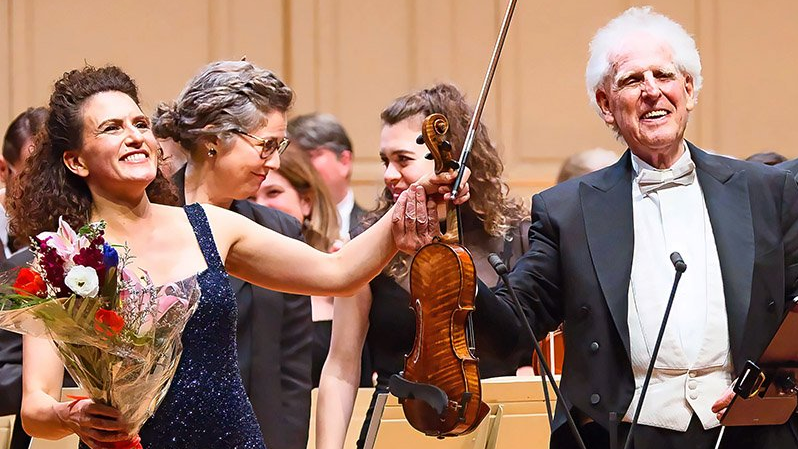Zander & BPO Realize Composers’ Visions

Saturday night’s Boston Philharmonic concert at Symphony Hall commenced with Ravel’s Pavane pour une infante défunte. Debuting as a piano solo and orchestrated by the composer in 1910, the six minutes of musical and emotional restraint go by in 4/4 time; it contains half, quarter, and eighth notes, and the occasional triplet, but nary a dotted note. The melody moves principally by seconds and thirds. The resulting enchantment, reinforced by the BPO’s cool and self-assured execution, opened a gripping evening.
Alban Berg dedicated his Violin Concerto “to the memory of an angel,” Manon Gropius, the daughter of Alma Mahler (widow of the composer) and the architect Walter Gropius, a beautiful, talented woman who died from polio at age 18. An adherent of serialism as developed and promoted by Arnold Schoenberg, Berg fused the former’s 12-tone technique with traditional tonality in this concerto. Putting aside its numbers, puzzles, and tone rows, audiences have loved this concerto for its emotional intensity. Soloist Liza Ferschtman understood and communicated its power.
The soloist begins, running over the open strings, accompanied by harp and flute. Thus we immediately enter a calm and tender realm. Frequent directives such as delicato, grazioso and tranquillo (presumably evoking Manon Gropius’s character) express the composer’s intent. Ferschtman’s violin sang with clarity and sweetness. Through the directives H and N (Hauptstimme, main voice and Nebenstimme, secondary voice), Berg clarifies the relationship between soloist and orchestral instruments. The exchange of thematic material came across clearly. Ferschtman adapted as well to the N as well as the H. The second part of the first movement features a Carinthian folk melody, which soloist and orchestra imbued on this night with a jaunty character. The second movement starts with a storm of dissonance. The concerto ends with a chorale from Bach’s Cantata BWV 60, Es ist genug. Berg’s tone row (which is played right after the intro) ends in four notes (B, C sharp, E flat, F) that are spaced a whole step apart. Bach’s chorale begins with four notes spaced a whole step apart. Berg uses Bach’s harmonization as well, although he varies the choice of instruments. A complex ending that this listener did not fully absorb, put across musical ideas and expressive power that we could savor even without fully comprehending.
Prompted for an encore, Ferschtman selected the first movement, Sunrise / l’Aurore, from Ysaÿe’s Sonata for solo violin no. 5 in G Major, op. 27, to add a note of hope on the second anniversary of the war in Ukraine.
Mahler’s First Symphony begins on A, spread across 7 octaves. In his pre-concert lecture, Zander called the opening “the tuning of the universe.” Mahler’s directive Wie ein Naturlaut informs the listener that this will be a journey through nature. And indeed the orchestra’s ppp on the first note inspired awe. Against a continued hushed background of descending fourths and arpeggios in A, the cuckoo sounds. This is the first forte (actually sf ) of the piece. A descending fourth from a single clarinet, pierced the imaginary mist with mellow and beautiful sound. But Mahler also brings to mind the bustling sounds of the forest, with the soothing pp of the horns, playing in thirds, fourths and sixths. Again the orchestra’s control of dynamics and color astonished us. Having taken comfort in our scene of nature, we hear the melodic material emerge in the celli (m. 62). Here Mahler quotes himself, recycling the second of his Wayfarer Songs, “I went this morning over the field,” as a tuneful, cheerful melody. The composer consistently gives the directive gemächlich, or leisurely. And Zander set a tempo, by his own admission (in discussion with this writer), slower than in almost any other interpretation. The tempi, and courageously soft dynamics, engaged the listener to the fullest extent. This theme and fragments thereof form the hallmark of the first movement and ultimately of the entire symphony. The composer takes us through thematic iterations and the bird calls we heard at the outset. Traveling through various tonalities adds to the complexity of the journey and to the unsettled emotional state. Mahler often asks for zurückhaltend or holding back. Only at the coda does a feeling of triumph reign as the two-note theme returns and the horns and strings unite in a triumphal D major close.

Schalltrichter in die Hohe (Hilary Scott photo)
Movement II is a peasant dance with a motif that emphasizes the weak part of the second beat. The rhythmic precision of the orchestra brought out the rough character. Another “off kilter” aspect is the composer’s directive Schalltrichter in die Hohe. Mahler instructs horns to hold their bells aloft to produce a stronger, louder and more strident sound. The horns accomplished this without disrupting the overall flow. It is the kind of detail BPO excels in, and one among many which allowed the ensemble to realize Mahler’s vision of a difficult, complex, and unforgiving world.
In Movement III Mahler turns Frère Jacques into a funeral march. Normally heard in a major key, here it is in minor and played pianissimo. A double bass introduces the theme against a two-note background (falling fourth) provided by the timpani. Following the usual round form of Frère Jacques, the bassoons and bass tuba are the second and third instruments to enter. The deliberate pace, hushed pianissimo and dark color evoked by these four instruments proved mesmerizing. As the Jacques tune disintegrates, a Jewish lament, played by the oboes in thirds, takes over. Their sensuality and lush sound, warm though still melancholic, contrasted dramatically with what had come before. The orchestra then turns itself into a small klezmer band, evoking a Jewish wedding. Joyous, yet pained, off kilter and dare I say, neurotic. Mahler never stops challenging the status quo. When we return to the funeral march, a gorgeous trumpet duet underpins the main theme. Frère Jacques is heard one final time before the movement ends with timpani and basses playing falling fourths with the steady grace heard at the outset.
The last movement, Stürmisch bewegt (moving like a storm), issues forth with a cymbal crash, loud, dissonant chords, and a timpani roll. Once again bourgeois complacency is assaulted. Mahler’s unconventional instructions continue. Quotes from preceding movements abound but now occur in a disorienting manner, like a distant echo. Two lyrical sections precede the conclusion with fanfare material from the beginning and an unexpected octave drop.
The strengths of the evening lay not only with the performances, but also with the relationships among the compositions. Zander had opined that had Mahler lived another 25 years (not impossible, given that he died at the age of 50), he could have composed the Berg Violin Concerto. And indeed, Mahler’s pushing of all musical boundaries led in part to serialism and atonality. Mahler’s presence also hovers in the Berg through its dedication to Alma’s daughter. Mahler is also evoked in Ravel’s dedication to a dead princess. In writing Kindertotenlieder (Songs on the death of children), Mahler seemingly anticipated his own grief over the loss of his young daughter two years later. The cycle’s poet Friedrich Rückert had lost two of his children to scarlet fever. Though serious composers grapple with all aspects of the human condition, writing music for the death of children [Erlkönig of course comes to mind] constitutes an uncommon practice.
The audience expressed its thrill with the Mahler, and as in the Berg, marked the end with an extended standing ovation. Zander celebrates his 85th birthday next Sunday at a concert of the BPYO.

A happy capacity crowd (Hilary Scott photo)
Click here to view the Program.
Click here to listen to Ben’s introduction to Mahler’s Symphony no. 1
Click here to listen to Mahler’s Symphony no. 1.
 Dinah Bodkin - The Boston Musical Intelligencer
Dinah Bodkin - The Boston Musical Intelligencer